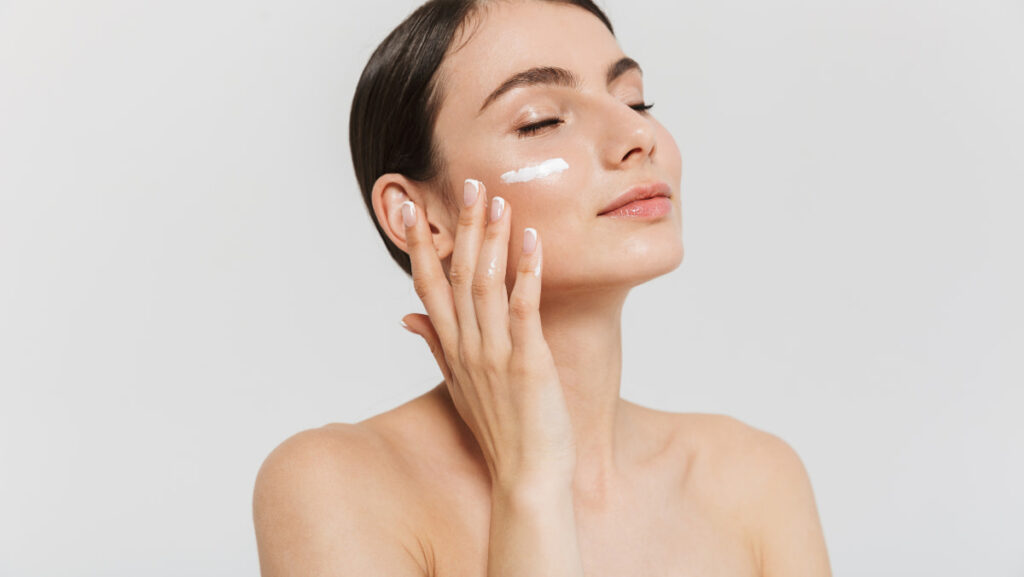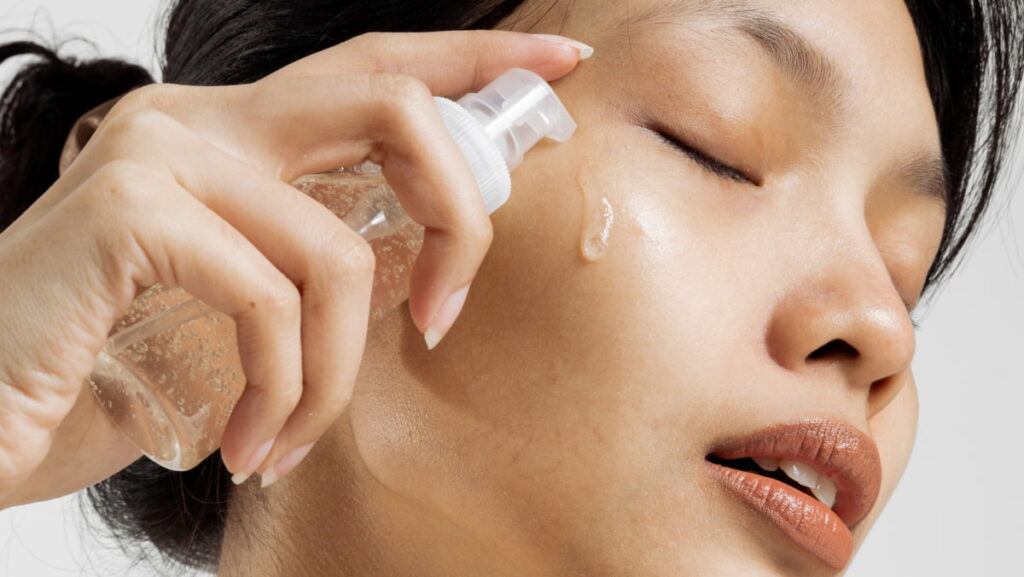
Glycolic acid and niacinamide will become your skin’s new best friends. These top-tier skincare ingredients can pack a powerful punch when it comes to improving the appearance of your complexion.
If you’ve been seeking products that will visibly improve the health and appearance of your skin, then you’re in the right place.
You will especially appreciate the benefits of glycolic acid and niacinamide if you’re dealing with skin concerns such as uneven texture and tone, breakouts, or signs of aging.
These amazing ingredients can deliver noticeable improvements in your skin’s health and aesthetic and are suitable for most skin types. The best part? They can be combined.
Let’s explore the benefits of glycolic acid and niacinamide and how they can transform your skin for the better!
Understanding Glycolic Acid: The Basics

What Is Glycolic Acid
Glycolic acid is an exfoliating alpha-hydroxy acid (AHA) coming from sugar cane. Its small molecular size makes it the tiniest AHA in the skincare arsenal.
This unique characteristic allows it to penetrate deeply into the skin. However, glycolic acid is water soluble, which means it still cannot penetrate as deeply as the oil-soluble BHAs.
Glycolic acid has anti-inflammatory, keratolytic, and antioxidant effects that result in its exfoliating and rejuvenating abilities. It works by breaking down the bonds of the cells at the outer skin layer, sloughing off dead skin cells, resulting in a brighter, even-toned, and smoother complexion.
A powerhouse ingredient like glycolic acid comes with precautions, though. Despite the amazing benefits, overdoing it can leave your skin dry and irritated. So, how much is too much?
Generally, products with a glycolic concentration of 5-10% are safe for daily use, while peels containing 20-30% glycolic acid should be used no more than once or twice a week.
Benefits Of Glycolic Acid
Glycolic acid has been studied for its numerous applications in dermatology. Let’s explore the impressive benefits of glycolic acid for the skin:
1. Glycolic Acid Exfoliates The Skin
Glycolic acid breaks the bonds between skin cells, allowing the skin to shed dead skin cells. Exfoliation exposes younger cells to the surface, leading to a more even skin tone and texture.
2. Glycolic Acid Reduces Acne And Acne Scars
Glycolic acid can help unclog pores, regulating acne breakouts. It also improves the appearance of acne scars and post-inflammatory hyperpigmentation, leading to improved overall appearance.
3. Glycolic Acid Reduces Signs Of Aging
Glycolic acid stimulates collagen production and promotes cell renewal, therefore, fighting photodamage that presents in the form of fine lines and wrinkles.
4. Glycolic Acid Fights Hyperpigmentation
Glycolic acid can correct uneven skin tone due to its ability to reduce hyperpigmentation. It is also effective against conditions like melasma.
Who Will Benefit From Glycolic Acid
Glycolic acid is a versatile ingredient with proven efficacy in various skin conditions. Who will benefit from glycolic acid:
- Acne or post-inflammatory scarring
- Aging skin due to photodamage or natural processes
- Melasma
Avoid glycolic acid if you have highly sensitive skin unless you have the supervision of a dermatologist.
Glycolic acid fights photodamage but also causes sun sensitivity. That is why you should always use it with strong SPF protection or at night.
Can you combine glycolic acid and salicylic acid? Find out here!
Niacinamide’s Role in Skin Care

What Is Niacinamide
Ever wondered about the secret behind some skincare products that provide that miracle touch? Here’s the answer: Niacinamide.
This skincare superstar is a form of vitamin B3 naturally produced by our bodies. It is famously known for its multiple benefits for the skin. Trust me when I say that niacinamide does everything and is for everyone!
Benefits Of Niacinamide
Niacinamide is a jack of all trades. Studies prove that it is an all-around ingredient. Let’s explore the benefits of niacinamide for the skin:
1. Niacinamide Moisturizes The Skin
Niacinamide enhances the skin’s natural barrier, preventing transepidermal water loss and increasing skin moisture. An additional benefit of protecting the skin’s barrier is reduced sensitivity and susceptibility to infections.
2. Niacinamide Regulates Oil Production
This property arguably made niacinamide a skincare superstar. Niacinamide regulates oil production, minimizing the appearance of pores and preventing breakouts.
3. Niacinamide Has Anti-inflammatory Properties
One of the top perks of Niacinamide is that it’s renowned for combatting inflammation. If you’re suffering from acne or rosacea, niacinamide provides a soothing effect. Similarly, regular doses can reduce redness and counter blotchiness, yielding a more balanced skin complexion.
4. Niacinamide Corrects Hyperpigmentation
Niacinamide is known for reducing the deposition of melanin, the pigment responsible for dark spots and hyperpigmentation. Regular use of niacinamide can lead to a more even skin tone and a reduction in the appearance of discoloration.
5. Niacinamide Reduces Signs Of Aging
Impressively, niacinamide can also make the skin look younger by improving skin structure and skin tone, improving the appearance of fine lines and wrinkles.
Who Will Benefit From Niacinamide
Whatever your skin concern is, niacinamide can probably help. Here is who can benefit from it:
- Oily, acne-prone, and inflamed skin
- Aging, hyperpigmented skin
Niacinamide is generally a well-tolerated ingredient by most skin types. You can use it both in the morning and at night with the rest of your skincare routine.
Find out about skincare combinations with your beloved niacinamide. Whether combined with salicylic acid, tretinoin, or hyaluronic acid, it’s always the star of the show.
Combining Glycolic Acid and Niacinamide

Can You Use Glycolic Acid And Niacinamide Together?
I have already spilled the tea, but I’ll repeat it for my friends in the back. Can you combine glycolic acid and niacinamide? Yes, you can!
However, there are some pitfalls with their combined use you should avoid to keep irritated and unhappy skin at bay.
Let’s explore why combining glycolic acid and niacinamide is a good idea and how you can pair them for maximum effectiveness.
Glycolic Acid And Niacinamide: Why It Works
Glycolic acid and niacinamide are two ingredients that do not disappoint. But why would you consider using these two together?
Well, when combined, these two ingredients synergistically enhance each other’s effectiveness.
Niacinamide works to restore the skin, making it strong and resilient, which can handle the powerful exfoliating action of glycolic acid. Glycolic acid sweeps away dead skin cells, and then niacinamide comes in to soothe and strengthen the fresh new skin.
The glycolic acid and niacinamide combo also boasts enhanced action against hyperpigmentation, aging skin, and uneven skin tone and texture.
How Can You Combine Glycolic Acid and Niacinamide?
There are several things to consider before deciding to combine glycolic acid and niacinamide.
First of all, these active ingredients have significantly different pH levels. Glycolic acid works best in acidic environments of 2.8 to 3.8. On the contrary, niacinamide is more alkaline, with an optimum pH level of 5-7.
Mixing glycolic acid and niacinamide will cancel each other out due to pH incompatibility. Also, it enhances the chances of an adverse reaction caused by niacinamide, called “niacin flush.”
Typically, niacinamide has a neutral pH, but under acidic conditions, it can convert into niacin, another form of vitamin B3. The niacin flush is characterized by temporary episodes of hot, red, and flushed skin due to the release of prostaglandin D2. It will go away, but it will not be pretty…
Therefore, do not attempt to mix glycolic acid and niacinamide. Read on to discover how to combine them efficiently and safely:
Find A Product That Contains Both
You cannot mix glycolic acid and niacinamide, but the science of product formulation can! These thoughtfully formulated products prioritize stability and efficacy, with often disclosed pH levels.
It’s worth noting that while they offer convenience as all-in-one solutions, the potency of the active ingredients may be slightly lower, and the pH level may not be as ideal as in individual products.
Amazing Products Containing Glycolic Acid And Niacinamide:
- COSRX AHA 7 Whitehead Power Liquid
- Versed Weekend Glow Daily Brightening Solution
- Kate Somerville KateCeuticals Resurfacing Overnight Peel
- L’Oréal Paris Glycolic Bright Daily Foaming Face Cleanser
Use Them In Different Routines
Instead of risking by using them in the same routine, you can use niacinamide in the morning and glycolic acid at night. This way, they’re not competing for skin absorption or increasing the chances for the “niacin flush.”
It’s recommended to use glycolic acid at night, as it can make your skin sensitive to sun exposure. You can use niacinamide both in the morning and at night, depending on your skin’s specific needs.
Apply Them on Alternate Nights
Another approach is to use glycolic acid and niacinamide on alternate nights. For example, one night, you can apply niacinamide after cleansing, and the next, use glycolic acid.
Remember that you can use niacinamide both morning and night. However, glycolic acid is safer to use when you are not exposed directly to sunlight.
Layer Them Properly
You can use glycolic acid and niacinamide in the same routine. However, it’s crucial to layer them correctly.
When layering products, start with the one with the lowest pH first. This will be your glycolic acid, which you’ll apply straight after cleansing. Leave it on your skin to do its thing for a good 30 minutes.
A gap of 30 minutes between applications is absolutely necessary. This waiting time allows for the skin’s pH to restore to its natural levels and prepare to receive niacinamide.
So, there you have it! Combining glycolic acid and niacinamide in your skincare routine can maximize the benefits of each, providing smoother, brighter, and healthier-looking skin.
Safety Tips For The Glycolic Acid And Niacinamide Combo
Glycolic acid and niacinamide are a match made in heaven, but as you noticed, there are some warnings you should head when using them together:
- Do not ever, ever, ever mix the two.
- Always wait at least 30 minutes after applying glycolic acid to go in with niacinamide.
- Avoid applying glycolic acid in the morning unless fully protected from the sun by sunscreen and a chic hat.
Conclusion: Glycolic Acid and Niacinamide’s Influence
When it comes to skincare, ingredients matter. Glycolic acid and niacinamide are two power players that can have substantial benefits for your skin. Combined, they can make an even greater impact!
When used correctly, glycolic acid and niacinamide can complement each other effectively. Glycolic acid first exfoliates and preps the skin, allowing niacinamide to penetrate deeper and work more effectively.
Glycolic acid and niacinamide together can provide a balanced, effective approach to skincare. So why not give it a try? With committed use and patience, you’ll begin to see the radiant, healthier skin you’ve always wanted.
Frequently Asked Questions
